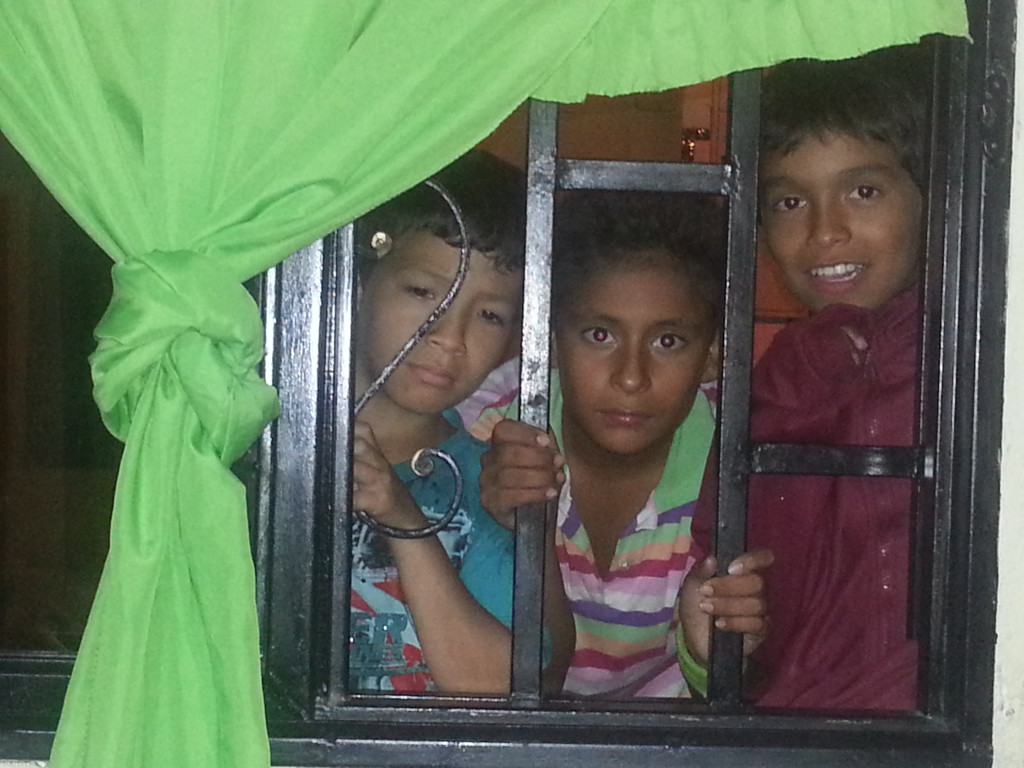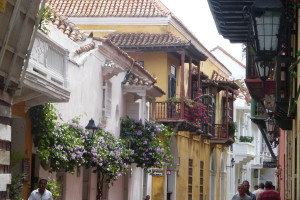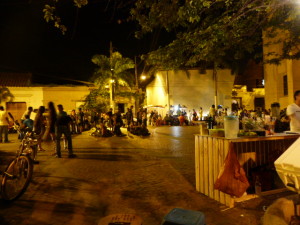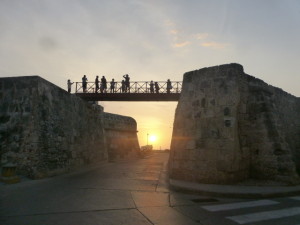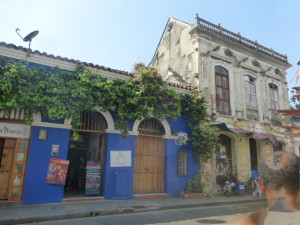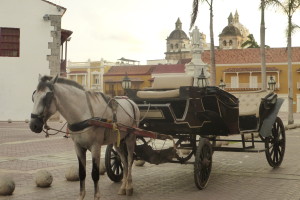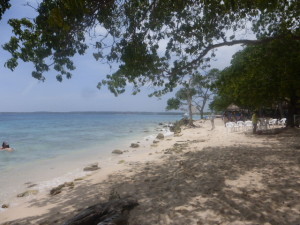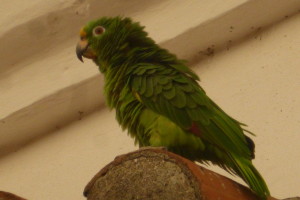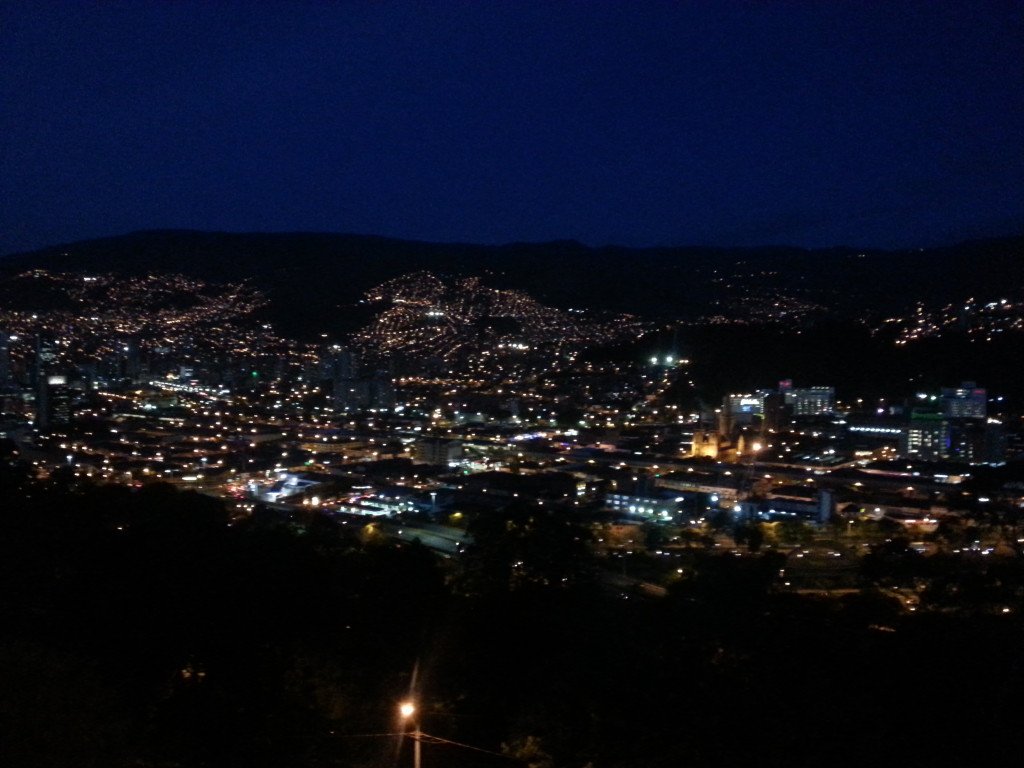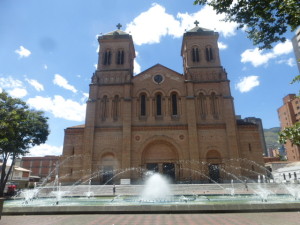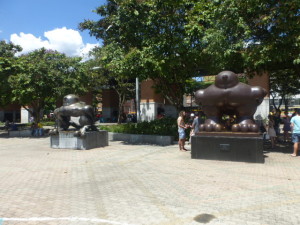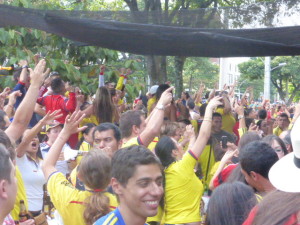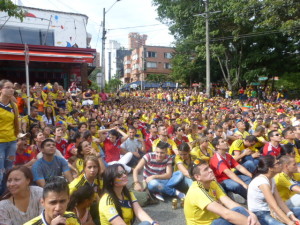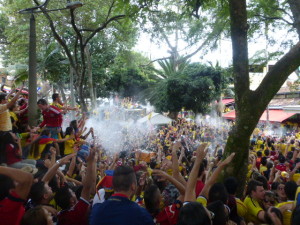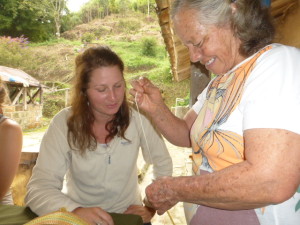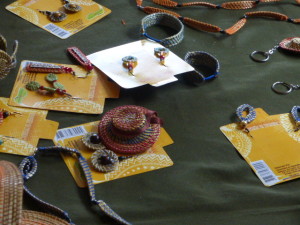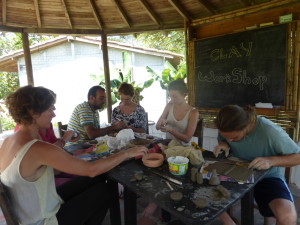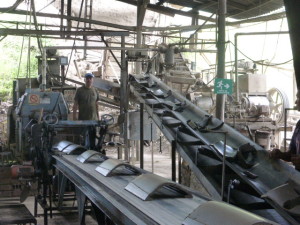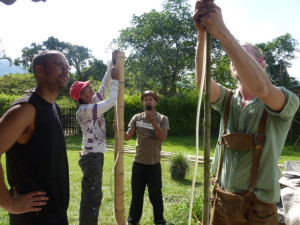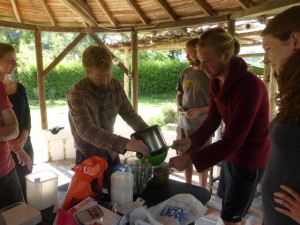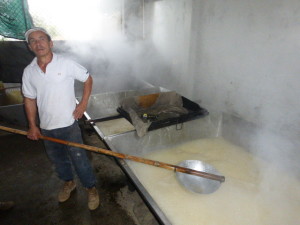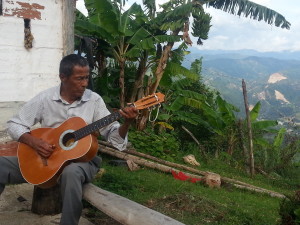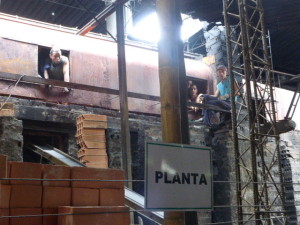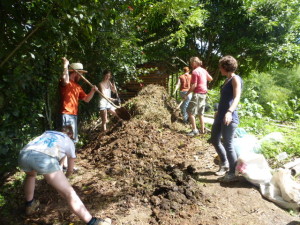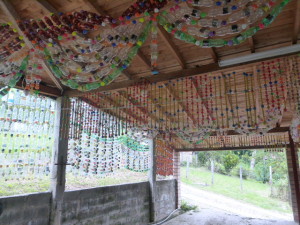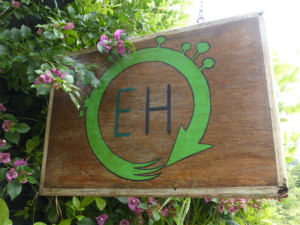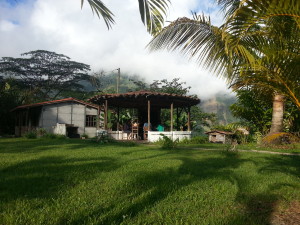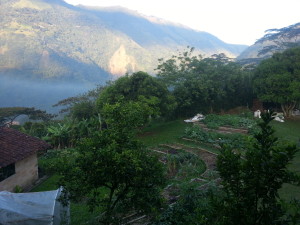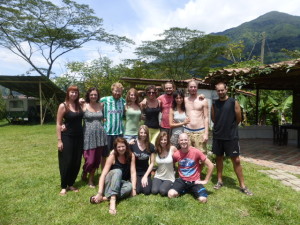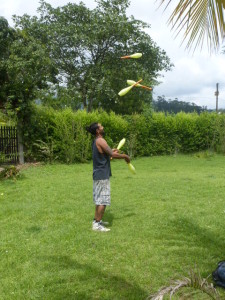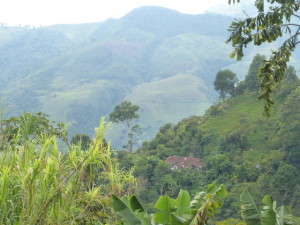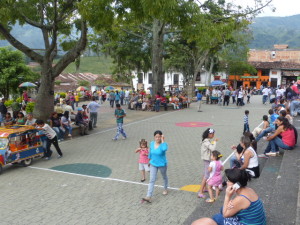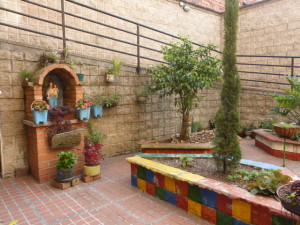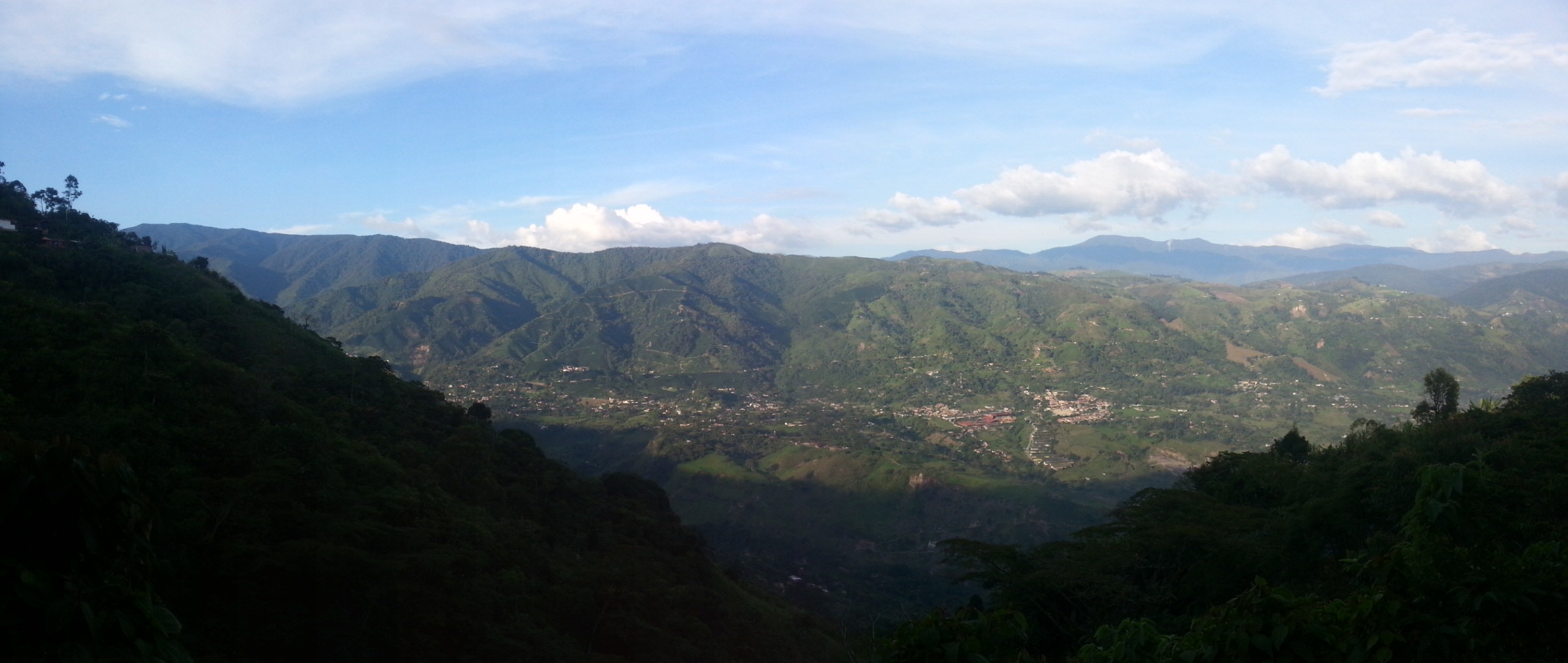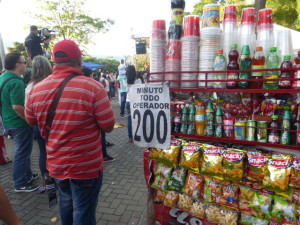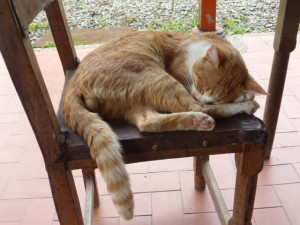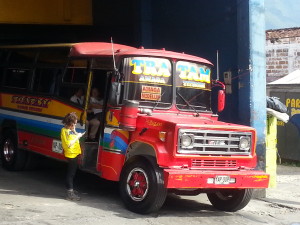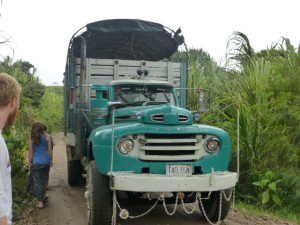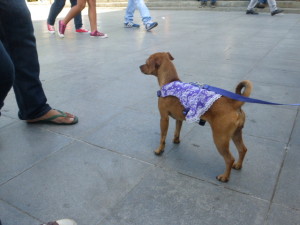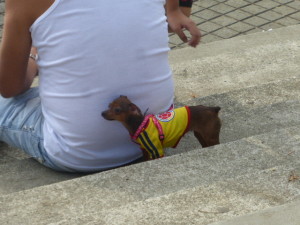
by Jane | Oct 8, 2014 | Colombia, Destinations, My travels |
As the end of my original planned five weeks at the Ecohostel drew nearer I knew that I wasn’t ready to leave the area yet. Amagâ is a small mountain town where not a lot happens but it is one of the places on my trip that has stolen my heart.

the mountains around Amaga
Paola arranged for me to move in with a family and to teach English to the seven year old who I shall call Abra. So one weekend I moved from my shared dorm in the hostel with its cold showers and (very nice) vegetarian food to a place with a pool, my own room and massive grounds.
My routine was flexible but I began every morning with an hours walk back to the hostel so that I could continue with my Spanish lessons. Paola had replaced herself with Lu so that she herself could travel for a month and Lu from Mexico endeavoured to continue my education.

a pool with a view
I may have moved to a lovely home but this was still Colombia. Several events had the family laughing at me over and over again – from my shower which burst into flames above my head and dowsed me in thick smoke and flames, to the giant ants which set up a nest in my shoes. A dangerous spider was marching across my bedroom floor one morning – had it bitten me during the night I would have had to spend three days in hospital and the cockroaches and beetles were the two inch long variety.

these things actually manage to fly
Abra had an adorable four week old kitten which clambered everywhere and Abra just loved to kick a football around. I played handball with the sports team on one of their days out when as a group we all went for a hike into the countryside and I helped out with the basketball trainingat the town sports hall. I also taught English to a great seven year old girl (Juli) at her home and often Abra was joined by Jac – the thirteen year old daughter of the lovely Vivi who helped out at the big house.
I went out a couple of times with Mauri into the campa. Maura speaks fluent English and German as well as teaching Spanish and told me many stories and tales about the area. On one occasion we trekked slowly in the searing heat, stopping to swim in the crystal clear pool of a river which tumbled refreshingly cold down from the mountains and then we poked our head into the dark entrance of one of the (probably illegal and unregulated) coal mines. We also had a beer at a football pitch on top of the world. Up here there was a three hundred and sixty degrees panoramic view where the mountains just marched on and on in their green folds for ever and ever.

fresh cold water from the mountains
I popped in and out of Medellin and I also stayed for a while at the Ecohostel whilst Paola was away. That was challenging – not least because one of the big humpback cows got onto the land through a hole in the hedge. Me and the amazing dog Guia managed to herd it back out of the gate (four times) and stopped it doing too much damage. It was a massive animal and not very sweet tempered but I was very proud of myself that we accomplished that between us before it could eat or trample too many of the vegetables.
Before I set off on this Latin American adventure I was always nervous out by myself and I would avoid walking out in the dark or the countryside alone. But now I was walking miles and for hours down country lanes. I wouldn’t freak out when a truck or motorbike slowed to talk – in fact I was actively hitching rides from them and as for living in the middle of nowhere all by myself – some of my friends would never believe it possible.

hitching on the back when the truck is full
I met up with Diego a couple of times for English/Spanish intercambio. One night I was unable to return home to the big house because the guard dogs were roaming free during the night and the odds were high that I would get eaten if I attempted to open the gate, D’s mum insisted that I stay and she gave me dinner and then made up a bed for me in the spare room. I cannot get over the kindness and the generosity of people here in this small town. They never see anything as an unsurmountable problem and they are full of trust and sunshine.
I was invited to dinner with families when before eating I would be introduced to the neighbours and local kids would hang through the bars on the living room windows watching me eat. I will be a lot more sympathetic when I next visit a zoo and stare and watch the penguins because it is very weird to be watched and listened to while you are trying to get on with other things. Everything happens in the open here – even the Alcoholics Anonymous meetings take place with the double doors open to the street because it is so hot – and whilst everybody can see the semi-circle of people gathered I guess that it is such a small community there is no way very much can be anonymous.

these kids watched us eating for ages
Yo and his partner Joha always have an open house in the town – for people and animals. They are both involved with a local community group called Corporacion Cultural Poncherazo and Yo also organises an intercambio language group with the volunteers from the EcoHostel. People just drop in and out of their home and they seem to know EVERYBODY in the town. They are both mad keen on animals and they have adopted some of the street dogs and cats, taking them into their home at night and leaving bowls of food and water outside their door for the others. I lived with Yo and Joha for nearly two weeks at the end of my stay in Amaga and I cannot thank them enough for showing me such kindness. I was living with them close to the centre of town and I was a part of the community.

my favourite street dog, Orejas (Ears) I would adopt him if I lived in Amaga

the view from my kitchen window for a few weeks
Night life in Amagâ is low key but fun with a couple of bars and nightclubs. One rather odd place even has the mens urinal at the side of the dance floor!! There are a couple of hotels (love hotels) where people check in for the night or part night so that they can get some privacy and countless bars with some very colourful locals who are often rolling drunk but funny and harmless and spend their days in the parque or in the market.

Amaga on a sunny Sunday afternoon, complete with childrens car ride
Colombia is one of the richer countries that I have visited so far in Latin America but there are massive differences between here and my old home in the UK. For the majority of people here, their social interaction with others is of the highest priority – both for the simple act of connecting and sharing with others and also because good manners have been instilled into them from an early age. The children will just as quickly approach and ask very politely how you are, or ask where you are from, engaging in a conversation, just because they can.

just an ordinary mountain town
Shopping takes on a whole new meaning as shopkeepers serve several people at once and all contribute to a five or six way conversation about what is being bought, the price, why you want the product and the news of the day. I have finally got used to being in the middle of being served and then abandoned for another customer – but that just means that the customer to my left can start a conversation with me. I am also now used to interrupting the customer who is being served and asking the price of something and I no longer feel embarrased when the shopkeeper abandons them for me. Its just the way that it is here.
I am sure that I will return to Amaga and the region of Antioquia one day. In the meantime I take a little piece of it and its inhabitants away with me in my heart.

public transport mountain style
On my final bus ride out of the town I sat on the left hand side so that I could drink up the views for one last time. I had my dark sunglasses jammed on tightly and I wept a few tears at leaving. I really hope that I will be back one day.

by Jane | Sep 24, 2014 | Colombia, My travels |
I finally dragged myself away from Medellin and I hit the night bus for Cartagena. After yet another twelve hour journey through twisty turny mountain roads I was deposited on the outskirts of Cartagena. Stepping from the ice cold bus I immediately broke out into a sweat due to the intense searing heat and the humidity and I was to remain a hot, damp sweaty mess for the following five weeks. I was so damp that the metal clips on my bra got rusty!

Old town, Cartagena
If you remember the film Romancing the Stone you will know that it is about a writer called Joan Wilder who ends up having all sorts of adventures in Cartagena with Michael Douglas. It became a bit of a family joke that I (Jane Wilder) may eventually end up in the dangerous Colombian countryside so I was keen to check out the area.

Parque Trinidad buzzes at night
I was intially disappointed to discover that no filming was acutally done in Colombia and that no snappers (alligators) are roaming around in catacombs under the old city walls.

gathering on the walls to watch the sunset
However, Cartagena did not disappoint. I had the best of times here and as is becoming a bit of a pattern, I ended up spending a lot more time around here than I originally intended.
To begin with I checked into the Mamallena hostel on Calle Media Luna. This street is a hive of activity and in my mind is THE best place to be located if you stay in Cartagena. These little streets throb. Yes, they are noisy and dirty and very overwhelming but it is nitty gritty life acted out in front of you everywhere you look. Just along the road by the park the prostitutes sit and watch the world go by, the beggars roam around in their rags searching through the rubbish and you will probably be offered all sorts of drugs, but don’t let any of this put you off. Everybody is very friendly and just getting on with their own lives in their own way.

Media Luna Street
There is the famous Club Havana salsa club on the corner of the street although the night that I got in there it was standing room only and no dancing was physically possible. There are countless bars, restaurants and clubs here and the walled city is just a couple of blocks away, so as I said, it is the perfect location

just hanging around
After spending almost a week here during which I visited the castle and I spent a night in a hammock on the idylic beach at Playa Blanca, a face from the past (a Frenchman that I had previously met in Medellin) turned up at my hostel. After a brief chat and discovering that we were both heading up to Santa Marta a few days later, me and Lio decided to team up and travel together.

the idyllic Playa Blanca beach
My time on the Carribean coast all began quite normally but it soon escalated into a time of craziness which spun me way outside of my comfort zone and ended up with me having half of my hair cut off!
You can read about that crazy time in a future post but I did survive and after nearly two weeks on the coast in which I was the victim of a failed robbery, I got invited to an ayahuasca ceremony and I almost got arrested on a beach I ended up back in Cartagena again.
I only intended to stay for four days this time because I had seen most of the city, but as usual I ‘got stuck’. I don’t know what it is about Colombia but I keep sticking.
Oh, I do know what it is about Colombia. It is the people that I have been meeting – Colombians and travellers alike – who have been marching into my life and forcing me to re-evaluate myself – and dare I say this – to actually begin to like myself!

these guys were wild in the old town

by Jane | Sep 10, 2014 | Colombia, My travels |
I was in and around Medellin for more than three months in the end, so it goes to show that first impressions don’t always count (mad cab driver)
The city is amazing! Similar to many others in Latin America it is situated in a bowl and surrounded by mountains but everything here is in perfect proportion. The ratio of the buildings climbing up the mountainside to the expanse of sky and the greenery, the climate which is rarely too hot or too cold and the people are so inquisitively friendly. Also, there is none of the claustraphobia of La Paz or the immense size of Quito. Medellin is perfect.

Medellin by night
Medellin was, until relatively recently, the most dangerous city on the planet and whilst it still has its dangers and it can be a bit edgy it has changed rapidly.
The government has initialised what is known as democratic architecture – which is when you take the most dangerous places and rebuild them. The hope is that this reclaims the streets from the criminals, giving people a pride and demonstrating that even the poor areas are worthy of investment. Plaza de Luz used to be a no go area, riddled with crime, drugs and guns but now it is a shining example of opening up a space (although it is still not advisable to visit it at night) with its modern library building and its tall light poles which stalk across the square.

Plaza de Luz
As part of this new development the city is now served by the most fabulous transport system. The metro train sweeps above the city on its concrete piers, a modern cable car serves one of the poorest barrios and whisks you up to Parque Avil and the escaleras electricas have made it easier for the residents in Comuna 13 to connect with the rest of the city. Bizarrely perhaps for us to understand, it is the metro system which symbolises the rebirth of the city from its dark days. You will not find one piece of litter or grafitti on it as the population carefully guard this most iconic representation of progress.

One of the gleaming metro bus stations
Cultural events abound in parques, and street art and libraries inform and educate. During my time in Medellin I went along to a samba festival which incorporated hip hop and street dance. The energy generated by the samba bands was over and above anything that I have experienced before with their complete love for the rhythms and dance. I went to a tango event, I saw French gypsy music and I watched Brazilian and Argentinian musicians play. I saw most of these events at the cool Centro Plazarte communal space in the rough-around-the edges district of Prado.

Plaza de Luz at night
There is a entire shopping mall dedicated to geekiness contianing what could be more than two hundred shops selling or repairing mobile phones and computers. I had met G one evening out dancing and when I asked him where I could get my broken laptop fixed he arranged to meet me at the mall and he helped me to negotiate a price and a repair. I believe that the store initially attempted to rip me off by finding a new fault with the computer and charging me nearly four times the original price. After they spotted me taking photographs and learnt that I write for a living they suddenly changed their tune and they couldn’t have been more helpful, keeping my computer for a few days and offering me to lend me one of theirs to take to Cartagena. I tell you this anecdote not to highlight the attempt to scam me but to demonstrate the kindness and generosity of the people. G spent hours with me waiting around, negotiating on my behalf and running me around the city on the back of his motor bike. He had met me once in a night club and simply wanted to help.

One of the fabulous Botero statues
Something which makes me chuckle is the pedestianised street in Medellin complete with traffic lights poking up between the crammed market stalls. This street was stealthiliy and illegally claimed by street traders who set up one, two then twenty stalls and by the time the authorities realised that traffic could no longer pass, they couldn’t be bothered to change anything, shrugged and so the street remains.

el centro
There is also a large square which contains two of Botero’s sculptures of birds. One is a mess having had a bomb explode next to it during the dark days and the other is a new one which was donated by the artist, although he insisted that the city do not remove the damaged one as a reminder of the high number of lives that were lost at that time.

bomb damaged and new by Botero
Like all cities in Colombia prostitutes parade outside one of the main churches, you can buy single cigarettes from traders with their little packed trays and drugs are readily offered as you wander about, but for the most part, everything is conducted under the watchful eye of the ever present police and ususally with a huge smile and good humour
I stayed for the most part in the barrio of Belen in a hostel cum apartment. Rubbing shoulders with backpackers in the dorm, longer stay guests and nomadic workers we shared food and conversations. Travel writers language teachers, musicians and artisans, medical students on a placement, an attorney and a digital marketer all connected and made the place a home from home

outside the liquor shops in La Setenta
I can’t end without mentioning the World Cup. The Colombian team and its supporters won the hearts of the world with their team spirit, salsa dancing and zest for life. I feel extremely priviledged and proud to have been in Colombia during this time when the atmosphere was electric and everybody, including the dogs, wore the gold football shirts
Whilst there was some trouble in some of the big cities on match days and alcohol was subsequently banned it says a lot that Medellin didn’t feel the need to impose such restrictions on its inhabitants.
I watched the Uraquay match in Calle La Setenta where every licor shop, cafe and club had rigged a TV and speaker system outside. The place erupted when Colombia won and the police good naturedly watched while the road was closed to traffic due to the sheer numbers of people celebrating.

waiting patiently in Parque Lleras
The final match against Brazil was AMAZING. A group of us made our way to Parque Lleras in the Poblado district where huge screens had been rigged up among the trees. The place was a sea of yellow with bottles of rum and aguardiente freely passing around. The crowd gradually became a little bit more subdued as it became obvious that Brazil would win and I did wonder what would happen at the final whistle? Anger, fights and trouble? The army and police had a heavy presence and the chances were that things could get ugly.

the final whistle blows and the foam erupts
The final whistle blew and… the place erupted. The Colombians had come out to party and party they would. Proud of their team rather than accusing them for losing they hugged and danced with strangers and celebrated. Music blasted out of houses and bars, drummers drummed and people bought cans of foam and we all had a massive foam fight running around like mad things. The clubs that night were full of gold shirts as the party continued and we stood for nearly half an hour in torrential rain at four in the morning trying to get a cab home.
I adore the city of Medellin.

by Jane | Aug 27, 2014 | Colombia, My travels |
Whilst volunteering at Paola’s Ecohostel Medellin we had the opportunity to take part in some workshops and field trips. Sadly the visit to one of the local coal mines didn’t happen (although I know that Paola was glad – in here words she said – the Ecohostel doesn’t support the exploitation of Mother Earth – but we did do some really cool stuff which you can read about below.
Grass workshop
Lilian, Luz Maria and Luis Fernando live on top of a mountain in the house that their father built. Everything had to be carried up on the back of a mule and even now, when they go shopping they bring goods up on their shoulders. The nearest town is a precise 18 minutes away but as an indication of how steep the mountainside is, it takes 30 minutes to get back. Lilian, Luz Maria and Luis Fernando are all quite a bit over the age of 60 but you would never think so as they are so trim and sprightly and have a zest for life that is not slowed by their age.

concentrating hard
They grow a specific type of grass which, after it is dried and coloured, the ladies sew into jewellery, purses and hats. Paola from the Ecohostel Medellin had arranged for us to visit this lovely family and after trekking for nearly three hours to their home we were treated to a tasty lunch and then we had a bash at making our own jewellery.
Once a month the trio travel to Medellin to sell their unique products at the awesome artisan market – but first they have to carry everything down from their mountain via the local town and setting off at stupid o’clock for the bus.

some of the amazing finished products
Clay Workshop
The clay arrived in a big tub and we were instructed to get down and dirty. The grey gloop had to be worked to the correct consistency and then silence descended over the Ecohostel Medellin as we concentrated. Clay flutes, an aeroplane, beads, salt and pepper pots destined for a display cabinet in the U.S. and even a backgammon board were produced. The finished products were then whisked away to a kiln to be dried out before being returned to us. My flute ended up in the bin as I dropped it while travelling but the backgammon board was very well used over the next few weeks despite the seed counters rolling away every so often.

silence as everybody concentrates
Roof Tile Factory
Like a scene from a Dickens’ novel this small factory produced clay roof tiles. We had often seen the clouds of black smoke from the kilns drifting up through our valley and now we could understand the process. Machinery as old as the hills transformed splodges of clay into tiles which were then piled up into the kilns over the ovens by a team of soot covered men and twice a week fired up. The work is hard and filthy and we would see the men walking back down the lane after their shift with bodies black with coal dust and just the whites of their eyes shining bright. Our own little clay products from our workshop found their way here to be dried out along with the hundreds of roof tiles.

making the roof tiles
Bamboo construction
Paola wanted to construct a roof over the little barbeque area at the EcoHostel Medellin. The wood was harvested from the little jungly area and then the men turned up to build it. Holes were dug and poles sawn, a roof added and voila – it was completed in no time. The one thing that fascinated me about this process was that there is an optimum time to harvest bamboo. It shouldn’t simply be hacked down but the time of the month needs to be considered. If you ever doubt the effects of the moon on our planet try cutting bamboo at the wrong time. The gravity of the moon affects the water in the wooden stems – pulling it up and easing it down in a natural rhythm. Cut when the moon (and tides) are strong and you end up with a wooden pole full of water!

the bamboo workshop
Soap Making
We made our own soap from used cooking oil. Like chemists we mixed and stirred our oil and the necessary acid NAOH sodium hydroxide to ‘cook’ the gloop. Care is needed here as te misture has a potential to explode! Essential oils can be added to make it smell sweet but we added lime juice and teatree oils as we wanted to use our soap for the dishes and laundry. With soap you have to be patient, waiting for a month or so for the chemical process to work but it is a great way to utilise that old cooking oil rather than simply dumping it. One of our volunteers had made soap in the States previously – and she showed us pictures of soap as pretty as cupcakes, whilst our product was more functionable

chemists at work
Visit to the Panela Factory
We set off in a jeep to a small village high in the mountains to the panela factory. Run as a local cooperative, farmers bring their sugar cane here twice weekly for it to be converted to panela which forms the basis for so many things here in Colombia.
Using very basic machinery the canes are stripped and pressed and the juices then boiled until caramelised. Worked by a team in large steel basins the sugary mess is then pummeled into submission and formed into round puddings to harden before being packed.

boiling the panela
A bottle that was bobbing around in the hot tank caused much interest as the worker would periodically swoosh boiling panela over it. What part of the process could a bottle possibly contribute? Umm – the man was simply heating his coffee back up.
Afte buying some panela we were then invited to Raul’s home high on a ridge with THE most spectacular views and he played his guitar for us. Traditional Colombian tunes filled the air with such simply haunting sounds – I know that I shed a few tears as did some of the other volunteers as he softly played and sang for us with the mountains of Antioquia tumbling down behind him.

Raul sings for us
Machete, machete, machete
This was not really a workshop but is a useful lifeskill to have. Why don’t we have machetes in the UK? Well balanced, they slice through most things with complete ease. Hacking down thick bamboo poles, chopping through the undergrowth or digging up weeds – these tools are amazing and I want my own. I am sure that adding machete handling to my CV will make future employers stand up and beg for me to work for them.

hot filthy work in the kilns
Bocachi
This is a Japanese inspired way of making a quick soil from crap. Yep – we were off into the fields opposite the finca with our shovels and collecting cow shit. These cows are free range eating the finest grass but they produce the sloppiest poos. By the end of our sessions we were plastered in the stuff!. Leaves, yeast malt and other stuff go into the pile which is then mixed and covered with a tarp. It heats up – and I mean it REALLY heats up and is turned twice daily. Within about ten days there is sweet smelling compost ready to spread onto the newly constructed terraces and it can be planted up. The climate in this part of the world is perfect for cultivating things and within four weeks we had tomatoes ripening in the new beds.

mixing the bocachi
Poker
I learnt to play poker. I loved this game. Buying a handful of beans, seeds and bamboo chips we gambled a couple of evenings away. Considering I had never played before I didn’t disgrace myself (although I didn’t win). We were serious but fun, sat in one of the tiny mountainside bars that litter Latin America drinking beer and eating lemon flavoured crisps.

local bar (poker den) ingeniously decorated with bottles
Bars here are set up on any piece of ground, often contain a pool table or french billiards (like snooker or pool but you play with just three balls and no pockets!!!) and are decorated in the most ingenious of ways with very little expense. Children usually play around, dogs pant and sprawl and music pumps out at full volume around the clock.
The above should give you a taster of the things that I got up to in my five weeks with Paola and the gang. In fact, I loved Amagá and the area so much that after my initial five weeks were up I moved in with a local family for four weeks and then I drifted back to the hostel for another two weeks

by Jane | Aug 12, 2014 | Colombia, My travels |
So, after an initial few days spent settling into Medellin I jumped on a local bus on a Sunday lunchtime and I headed off to the little mountain town called Amagá which is just 45 minutes south of the city. After being deposited in the bustling central parque an entire family helped me to locate one of the Willy’s jeeps which would take me up the rough track to the hostel.
And there I fell into another little slice of paradise. I struck gold with the location of the hostel, the owner, the other volunteers and all of the residents in the town of Amagá.

Ecohostel Medellin
The EcoHostel Medellin is fast establishing itself as a permaculture farm and guests here have various options. My week (and that of most of my fellow volunteers) went something like this:
On a good day I would get out of bed just as the mountains were turning a blue grey as the dawn broke and the soft mist would saunter up from the valley below. I would often attempt to meditate or I would join in a yoga session. Breakfast would be at 6.30 and then me and Nat (and later Mat) would head off up the tiny path up the massive hill to the little one-room primary school where we would endeavor to deliver an English lesson to up to eighteen adorable children. I take my hat off to their full time teacher who taught on four separate blackboards to an age range of between five and twelve year olds, all at the same time. She had the patience of a saint and a smile to go with it.

Spanish lessons in the outdoor classroom
After the English class we would have an hour and a half of Spanish classes with Paola in the most perfect outdoor classroom. It is tough trying to conjugate those bloody Spanish verbs but it was made far more bearable with the backdrop of the mountains rearing up over us, the vultures circling above us and the insects and birds squawking and chirruping away.
I also worked on the farm for two hours a day – and we usually managed to fit all of this in before a wonderful hearty healthy vegetarian lunch. The farm work varied hugely but could be anything and included planting and weeding, collecting cow poo from the field opposite, collecting leaves down in the jungly bamboo forest, clearing new paths with machetes, digging terraces and making Japanese bocachi (a quick compost).

one of the vegetable plots
Some of the volunteers would head off to teach English to the secondary school children in the afternoon, but having done my bit at the primary school in the morning I would either hang around in a hammock and recharge my batteries or I would head off in the other direction into the town. We would also take it in turns to attend an intercambio group consisting of adults and children in Amagá and which usually ended in a beer or two once the little ones had left.
Paola also organised various field trips and experiences for us all. I will tell you about these trips in a future entry but they included a visit to a panela factory, soap and clay workshops and a trip to the local roof tile factory.

our volunteer family
Permaculture is as old as the hills but seems to have got forgotten along the way as human beings have ‘progressed’. More and more people around the world are turning to this method of farming which involves working with the land, geography, climate and the natural resources. Water is used wisely, waste composted and the food is organic. It is a complete way of life and if you want to know more you should visit Paola’s place and do a stint here.
Although every batch of guests going through Paola’s place are great, I know that I was with the very best of the bunch. We were an unusually large group as some volunteers had just turned up to check out the place and ended up staying. Some lunchtimes there were sixteen of us around the large dinner table – the guests, Paola and her novio, Tia (aunt) and Mauri our juggling, acrobatic, samba drumming gardener.

our juggling gardener
We, the volunteers were a diverse bunch but we had the best of times. As well as the yoga and the meditation I had a massage from my Texan friend in the little outdoor schoolroom during the most spectacular thunderstorm, reiki and crystal healing from LL and I have it on good authority that a baby may even be named after me!
I had a magical twenty minutes in our darkened dorm room with my Swedish pal – no.. wait.. where we were totally mesmorised by a firefly which had somehow got in and which treated us to a Disney-type neon green dance as it floated and flashed around our heads whilst we oohed and aahed. Tinkerbell has to have been modelled on this phenomenen of nature and then on other evenings we would spend ages up on the high bamboo platform as dusk fell, watching the magical sparkles as the glittering bugs floated and swooped and danced in the trees and bushes, made all the more magical by their silence and the intensity of their green, orange and white lights.

the mountains go on for ever
With no internet, TV or radio at the hostel we would head into town to connect with the outside world. Often, walking along the track we would overtake horses or cows which were grazing along the grass verges, clamber up the ridiculously steep roads to the market and, past the outdoor area where you would see women doing the laundry, lads washing their motorbikes off and miners black with coal dust showering under the freshwater spring where the water gushed freely out of the mountainside. And there were of course many many times when a passing motorbike would stop and with no helmet I would jump on the back, or one of the Willy jeeps would stop, fully laden but would allow us to hang off the back ladder for free.
Many of the houses in Amagá have no running water and residents use the outdoor spring to collect drinking water, shower and laundry. It was always a bit disconcerting walking back from the town after dark and bumping into a silent cow or horse, but the show of stars above and the many glittering lights from the hundreds of houses scattered among the mountainside plantations gave the whole place a cosy feel.
The town has no museum or attraction to visit and there is no reason to stop there as it sprawls up the mountainside – BUT this is what makes it such a magical place and the EcoHostel Medellin perfect for a weekend stop or a more extensive break. Apart from the guests at the hostel you will be hard-pressed to find anyone from outside Colombia in Amagá and therein lies its secret, and of course it is just an hours bus ride away from the magnificent metropolis that is Medellin.

Amaga on a Sunday afternoon
The people here have to be the friendliest, most inquisitive, most generous people in the whole wide world. Whether you are sitting in the market trying to skype home, having a drink in one of the hundreds of little street side bars or shopping, people will come and talk to you. Men, women and children are inquisitive and so proud that you are in their town. They want to practice their English, invite you into their homes for dinner or pay for your beers or coffee. And always they have the widest smiles and the happiest manners.
And I can’t omit to mention the little town library. It is a little hub of activity and with the cutest little courtyard which is lovingly tended by Julio the great librarian, this has to be the prettiest library in the world.

the little library courtyard
After initially planning to stay for just five weeks I extended my visa and I remained in and around Amagá and Medellin for twelve which will give you some indication of how I fell head over heels in love with this place. I need to move on so next is Cartagena and the Caribbean coast. I need to move on so that I know if I want to return.
I could write forever about Amagá and the region of Antioquia, but I will try not to bore you. This area and its people wove a magic around me. Here I eventually found an inner peace and I am moving towards an acceptance of things that I am unable to change.

by Jane | Jul 26, 2014 | Colombia, Funky Facts, My travels |
Colombia is Colombia! But it’s Colombia!
Both of the above expressions can be heard over and over again, usually accompanied by a nonchalant shrug of one shoulder and a wry smile, and used to excuse or explain away just about anything that needs an excuse or an explanation.
Poor timekeeping, bad driving, any quirk of life that occurs – all are explained away with good humour and an unlimited amount of patience.
The following are not all restricted to Colombia but here they are certainly delivered with a lot of charm and the widest of smiles.
1. The Minute Man (or woman). This is minute as in time rather than teeny tiny people. On every street corner you can find somebody holding up a cracked laminated sign or they have a cardboard notice pronouncing ‘minutos’. Don’t have a cell phone? No problem. Simply use a mobile here and pay for the respective minutes that you have used – and they are cheap. More often than not the phone is tied by a length of string to the other person so you can’t run off with it, but it is the perfect system for people who don’t want to or can’t afford to buy their own mobile. It is also indespensible for travellers who like me still haven’t bothered to purchase a Colombian sim card or for safety reasons would rather not be out and about with a phone.

man on phone – you can just see the string
2. Poor timekeeping: the longer that I spend in Latin America I have come to realise that poor time keeping is not down to rudeness or insensitivity but it is just the attitude of a nation of people who generally live life more slowly and in the moment. This is forced on them to some extent by the bureaucracy and the craziness of the rules (when any rules do exist), the transport systems, the heat and an overall laissaz faire outlook on life. Colombians enjoy the moment. They will not pass a friend in the street without a good gossip and they will stop to pass the time of day with strangers – and if that makes them late for an appointment – well the chances are that if they are meeting with another Colombian then they will have done the same and they will probably both turn up at the same time anyway. So therefore there is no problem.

all the time in the world
3. Bus travel has been described to me by more than one Colombian as an extreme sport. Drivers are recruited on their fearlessness and their ability to keep the accelerator pressed flat to the floor, even when collecting or depositing passengers. Mothers with babies in their arms, twenty school children, crinkly old ladies with a sack of beans over their shoulder or men with boxes of chickens – the bus stops for no one. If you are very lucky there will be a conductor on board who will leap off and give you a not so gentle shove up the arse or take the chickens off you so that you have two hands free, and then the bus will lurch forward again, rolling all the newbies along the aisle. No need to shout ‘move along please’ – the g-force compacts everybody towards the back with little effort, with the already seated passengers holding up willing arms to catch the babies or the beans.

one of the better local buses
4. If bus travel is an extreme sport, then the roads are the adventure playground. Is that a solid double line down the centre? Does it indicate a hazard such as a blind bend or a dangerous corner? Yes, it does, but it is not a warning sign – rather a challenge. Look – a blind bend with a two thousand metre drop down a sheer mountain side – yep – overtake. Even better if you are a bus driver and you can try to overtake a line of long lumbering lorries – on a blind corner – in the mountains – and on the busiest road in the region – it makes the challenge longer and it certainly gets the heart pumping. Bridges under repair with no side safety barriers or carriageways which have been undermined by landslides – those maximum speed signs need to be doubled and then have a zero added to them for that added zing to life.

one of the oh so slow lorries
5. Michelada – This is a beer with attitude. The Colombians drink their beer with additives. Take a beer but first coat the rim of the glass with a hefty amount of lemon juice and salt. Then put a good inch of lemon juice in the glass and more salt before pouring in the beer. This is the standard although I have had a michelada which also contains pepper and chilli – and once one arrived with Worcestershire sauce in it! It’s almost a meal.
6. Arepas are EVERYWHERE and people can’t get enough of them. They are a staple food and probably more important than bread here. They are a sort of thick tortilla made from maize which you can eat cold but are better heated up over the gas flame on a little hot plate. Unfortunately they are served up with every meal – bread, lunch and dinner and I HATE them. I can’t quite put my finger on why I don’t like them as they are so bland and inoffensive but there is something of a vague off-putting smell about them. They come in various flavours but they are all horrible as far as I am concerned – on a par with papaya and sopa de mondongo – diced tripe soup (cow’s stomach). I give them away to people at the next table.
7. The mullet hair style is proudly sported all around the country. Gelled and spiked and a reminder of the eighties men are generally exceedingly well groomed and take amazing time and care over their hair and their clothes. I reckon Latin America has more hairdressers and barbers per head (did you get that pun?) of population than on any other continent. Shaved sides, little mohican stripes and rats tails are combed, groomed and preened in any available shiny surface. I have also spotted a large percentage of the men wearing clear varnish on their fingernails and most take an incredible pride in their physique and appearance. I like this trend.
8. Dogs are dressed up. Dogs wear clothe;, coats, scarves, hair ribbons and slides, booties and dresses. They even have football strips for dogs and like the men, they have a passion for nail varnish – well, to be honest, probably the dogs couldn’t care less but their owners do. In a place where the temperature is melting hot it strikes me as odd to add more layers to an already furry creature – although if they sold strait jackets for dogs I would buy one for the dog which tried to attack me the other week and bit the leg of my shorts.

doggie in a dress
9. Men wearing nail varnish and dogs wearing dresses are all perfectly understandable when you realise that the national obsession is looking good. This is historic and goes back to when the drug barons were the celebrities and dressed to kill (another pun there!). Now, not a man, women child or dog goes out without checking themselves in the mirror three times, full makeup is applied and clothes are always spotless and pressed stiffly to attention. Colombians nearly all sport tooth braces for that amazing smile and many women go under the knife and have cosmetic surgery. Many procedures are available in the poorer areas for free but for those who can’t afford to or would rather not add bits on to their bodies (yes they add on, they never deduct) then you can buy uplifting knickers and jeans with butt enhancing pads built into them.

doggie in a football strip
10. We were travelling in a cab late one night in Medellin when the cabbie blatantly ignored several red lights. Wondering aloud if we would actually make it to our destination in one piece or if we would be taken out by another cab doing the same, our driver explained that in Medellin it is actually legal, or at least tolerated for cars to jump red lights after ten o’clock at night. He explained that no driver wanted to sit around at a junction and run the risk of being robbed or shot and the police have enough to do without mopping up the pieces. So we decided that yes, we would rather take our chances at the junctions in the gapme of ‘Traffic Light Russian Roulette’ than that well known arcade game of ‘Shooting Sitting Ducks’.






